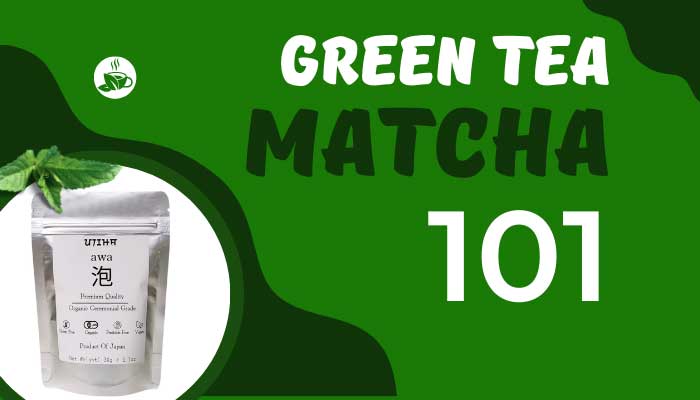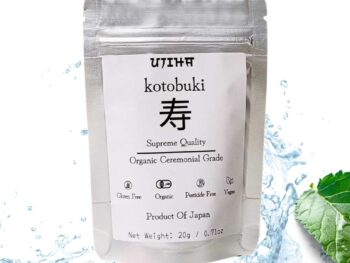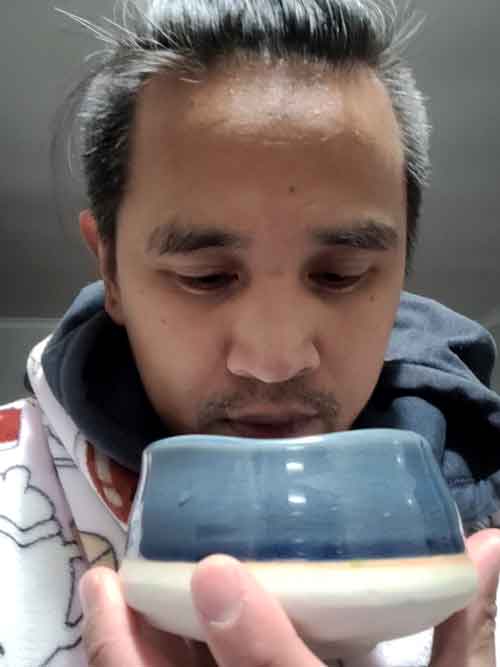Everything you need to know to embark on your matcha journey and achieve mastery. Or, you simply need to know how to drink this stuff the best tasting way possible. Welcome to matcha 101.
Matcha Tools
You don’t need tools to get started. You can achieve ok tasting matcha by using the bottle shake method, more on that later. But to get the best out of your matcha I recommend the following matcha tools:
- Matcha Bowl (Chawan): A wide bowl used for making matcha.
- Bamboo Whisk (Chasen): A special whisk for mixing matcha.
- Matcha Scoop (Chashaku): A bamboo scoop for measuring matcha powder.
- Sifter (Furui): To break up clumps in the matcha powder.
But if you don’t have money for all of that, keep reading…
The Only One Traditional Matcha Tool You’ll Ever Need
Get yourself a bamboo whisk, aka, chasen. While other matcha tools might not significantly impact the taste, the bamboo whisk stands out.
A sifter could be crucial if you’re not a fan of clumpy textures. Sometimes, matcha can form lumps that no amount of enthusiastic whisking will break up. However, with our matcha varieties like Awa and Ichi, sifting becomes unnecessary. You can bypass the whole sifting process and enjoy seamlessly smooth matcha right away.
So, do your taste buds a favor and buy a bamboo whisk and read on…
How To Brew Matcha With A Bamboo Whisk
Great stuff for buying a bamboo whisk, now go froth and brew matcha:
- Heat Water: Boil water, then wait about 5 minutes to let it cool to about 80°C (176°F). We recommend a thermometer to get the perfect temperature every time. Or, the best one is the variable temperature control kettles.
- Sift Matcha: Use the sifter to put 1-2 scoops of matcha into the bowl.
- Add Water: Pour 80ml of water into the bowl.
- Whisk: Use the bamboo whisk to mix the matcha and water. Move it quickly back and forth in a “W” shape until frothy.
- Add More Water: If you like, add more hot water or milk.
This water to matcha powder ratio is for beginner tea drinkers. We think it is the best ratio to enjoy the pure taste of matcha for someone new to tea.
For a much awesome tasting experience, we recommend either increasing the matcha powder or decreasing the amount of water.
You can stick to 1 gram of matcha powder and decrease the water weight to 60 ml. Or vice versa, increase the matcha powder to 2g but stick to 80 ml.
Honestly, you can play around with these numbers. Everyone’s palate is different after all.
Koicha or Thick Tea
The above tea we just prepared is called usucha or thin tea. When you’re ready for a boosted matcha taste experience, try koicha or thick tea.
I must warn you though, using culinary grade and lower quality matcha to make koicha will feel like being punched in the face by Mike Tyson in his prime.
Try Kotobuki. Our supreme matcha offering.
Preparing koicha is easy, just do the following:
- Heat water to 80°C (176°F).
- Sift 4 grams of matcha powder to the chawan (matcha bowl).
- Pour 30 ml or 40 ml of hot water.
- Use the chasen (bamboo whisk) to slowly mix the matcha powder and water to a paste-like consistency. The paste should be thick and glides easily.
- Enjoy the super-focused, mental clarity, this powered up matcha bring.
Brewing Methods Without Matcha Tools
You don’t want to or can’t buy a chasen? We understand. Heck, we used a spoon to whisk the matcha for a while, then the fork, a hand frother, and a protein shaker. Eventually tried the bamboo whisk and let me tell you, matcha tastes best when whisked with a bamboo whisk. But hey, we can’t force you. The following are alternative methods to make matcha without tools:
- Jar/Bottle Shake: Put matcha and a little warm water in a jar. Close the lid tightly. Shake it well until it’s mixed and frothy. Then, add more water or milk.
- Milk Frother: You can use a regular milk frother to mix the matcha. It might not be as frothy vs using a bamboo whisk, but it still works.
- Wire Metal Whisk: This is your regular whisk found in most kitchens. It doesn’t create as much foam and also noisy as hell. One thing for sure is that your roomies will know you’re preparing matcha.
- Spoon/Fork: Our least favorite method to whisk matcha that we definitely do not recommend is using a spoon or fork. Add matcha and water to a cup. Use spoon or fork to stir. Enjoy the lumpy matcha.
Knowing the best way to brew matcha is not enough to keep having that perfect matcha, you also need to learn how to store it properly to keep it fresh and at its best longer.
Storing Matcha
Properly storing matcha is the best way to preserve its nutrients and flavor. Matcha in a pouch-type packaging is not ideal storage for matcha after the seal is broken. The tin can adequately store matcha so long as you checked it is airtight by doing the water leak test. How to do the water leak test?
Fill your empty old can of matcha with water, cover it, dry it with a towel, shake it vigorously, then turn it upside down for hours. After a few hours, check for leaks.
The following are our recommendation to store matcha:
- Airtight Container: Use an airtight container to keep it fresh. Using a tea caddy or a mason jar with a rubber seal on the lid to keep the air out is the best way to store matcha.
- Keep it Cool: Store matcha in a cool, dark place. A cupboard and a fridge is good.
- Avoid Smell: Matcha can attract other smells and may stick to it. So, if you don’t want your matcha to taste like last night’s green curry keep it airtight.
- Avoid Light and Air: Light and air can make matcha lose its flavor.
Conclusion
Matcha is a delicious and healthy tea. Enjoy making it with traditional tools, or just use what you have at home. Remember to store it well to keep its fresh taste.
Enjoy your matcha journey!



